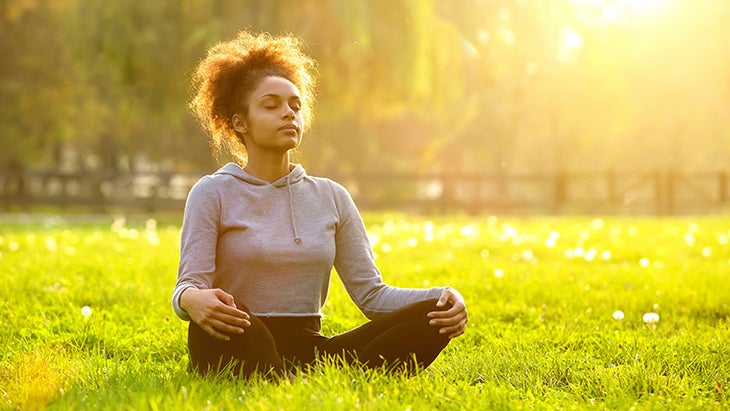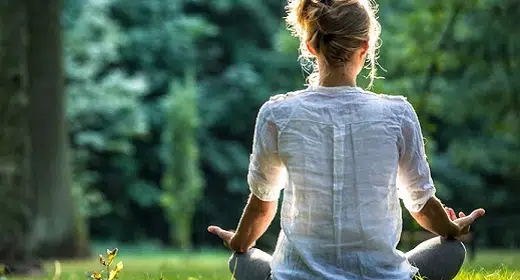by Sally Kempton: Meditation teacher Sally Kempton shares her tools for finding peace—even during life’s most overwhelming moments…
When my students tell me they feel frazzled or overwhelmed, I often ask, “Is there a place you go to in order to take refuge? A safe space to sort yourself out?” Some people look at me blankly. Occasionally, one bursts into tears. Others admit that their antidote to stress is turning on the TV, having a few glasses of wine, or tearing into a bag of chips. Sometimes, even trying to find a more creative way to relax can feel like one more demand.
I was considering this as I listened to Dennis, a 40-year-old who is trying to run a consulting business and feels uncertain about his future. What grounds him, he says, is spending time in the woods on a Saturday afternoon. He’ll sit on a fallen log or beside a creek and let his mind quiet down, noticing a beetle crawling up a tree or the texture of the moss on the rocks beside him. After an hour in the forest, his senses open to the natural energy around him. It’s that energy, he says, that keeps him going.
Dennis has found a way to take refuge. For him, it’s nature. For me, it’s meditation. When everything starts to feel like too much, I take the frazzled feeling as a signal that I need to sit down, close my eyes, and let my attention sink into my heart. Almost always, I come out feeling more centered and resourceful. Sometimes when I open my eyes, I find that a problem doesn’t even look like a problem anymore. There have been many times when resting my attention in my heart for five minutes has turned a bad day into a good one—a feeling of being stuck into a creative breakthrough.
Everyone needs to know how to take refuge. No matter how much you love your life, no matter how strong or motivated you may be, you will be overwhelmed at times. Maybe you’ll have to pick yourself up after a breakup, or maybe you’ll lose your job. You may simply have a hard week. At such moments, if you don’t have a habit of taking refuge, life will begin to feel like an endless treadmill. You’ll rely on the same old coping mechanisms, follow the same grooves, wondering why you don’t feel inspired or even, sometimes, able to cope. Consciously choosing to take refuge—and having a reliable way to do it—can help you find new reserves of strength, stamina, and inspiration.
Find Your Calm by “Taking Shelter”
The word refuge means place of shelter. But I’m not talking here about the basic physical shelter that every human being needs and deserves. I’m talking about the kind of shelter that lets you get in touch with your deepest Self, especially at times when you feel lost or overwhelmed.
What defines a refuge? First, it should help your mind calm down. Second, it should help you feel safe, even protected. On a normal day, it helps you stay connected to your center, to peace, or to the feeling that other human beings share your concerns. On a bad day, your place of refuge can restore your soul. A true space of refuge can also function as a kind of cocoon, where you retreat to do the sort of self-examination that leads to inner change. Just as lying in Savasana (Corpse Pose) can help you assimilate an hour of asana practice, retreating to your place of refuge can help you digest your life experiences. It can give you both rest and the wherewithal to act from strength.
Your refuge place can be a physical location—a meditation corner, a tree in your backyard, or even your bathtub. Or, another person can be a source of refuge—a friend, a relative, a partner you can call when you’re down, or a mentor whose advice you trust intuitively. Likewise, a repetitive activity, such as walking or biking, can offer an entry point into the space of refuge. And so, of course, does asana practice. That deep sigh—the “Ahhh” you often hear in yoga class as one person after another slips into their first asana of the day—that’s the sound of people finding refuge. The yogic sages warn, however, that a place, a person, or an activity will give you real refuge only when it connects you to something that feels timeless and eternal. To Spirit. To Soul. To the inner Self.
The great yogic model for unfailing refuge is the one Lord Krishna offers his disciple Arjuna in one of India’s most beloved texts, the Bhagavad Gita. In this epic tale, Krishna is Arjuna’s guru and charioteer; he also represents the embodied form of Spirit itself. On the eve of a great battle, the warrior Arjuna faces off against relatives and friends in a fight for the soul of his kingdom. Conflicted about whether it is right to fight, he turns to Krishna for advice. Krishna coaches him in the principles of yoga in action. But Krishna’s final teaching is this: “Take refuge in me.” He tells Arjuna that taking refuge will free him from fear of wrongdoing.
This dialogue between Krishna and Arjuna represents the eternal conversation between our individual self and our higher Self, sometimes called the inner Source or inner Spirit. The mythic character of Krishna embodies the inner wisdom of Spirit, the underlying creative Presence that lies at the heart of reality. At one point in the Gita, Krishna says, “I am the Self hidden in the heart.” He’s referring to one of the deepest pieces of wisdom in the yoga tradition: the teaching that in our own bodies, in the subtle center called the heart, we can tune in to our true Self, the part of us that isn’t confused about what life is all about. That Presence is the “me” Krishna is referring to and the great source of true refuge.
The mystic poet Kabir speaks of this Presence as “the breath inside the breath.” His point is that it’s always closer than you think. Once you’ve learned how to tune in to Presence, you have a refuge that you can turn to at any time, even in the middle of a stressful business meeting or an argument with your spouse. One way to tune in to Presence right now is to focus on the space in and around your body. Inhale and exhale, feeling that. With the inhalation, you breathe that space in through your pores; as you exhale, you breathe it out. After a while, you should become aware of a subtle, delicate energy that is both inside your body and around it. According to the yoga tradition, this is Presence—and it is close to you at all times.
2 Ways to Tap Into Presence
Once you recognize what being in Presence feels like, you’ll probably realize that it’s always been implicated in your moments of peace and safety. For example, if you think about times when you’ve felt deep refuge in your yoga practice, you may recognize that those were times when you managed to tap into the sense of Presence—the living energy within your body and breath. You may also realize that the feeling of comfort when you’re with certain friends, or when you open the door to your beloved, is not just the effect of a neurochemical rush. It comes from being connected to the living energy of Presence that runs through the two of you. One of the timeless ways people experience the refuge of unconditional Presence is through the natural world.
The great eco-philosopher Thomas Berry points out that “the mountains and rivers and all living things, the sky and its sun and moon and clouds, all constitute a healing, sustaining, sacred presence for humans, which they need as much for their psychic integrity as for their physical nourishment.” And though the most powerful experiences of Presence in nature often happen in wilderness, you can also find them in your backyard, a suburban woodlet, or a park.
When I lived in New York City, during moments of stress I’d sometimes find myself gazing out my window at an Ailanthus tree, sprouted in a little patch of dirt carved out of the sidewalk. I didn’t understand why I felt so soothed by that little tree, but I’ve since come to realize that in a highly urban environment, it offered me a doorway into that healing, sacred Presence that Berry talks about. Here are two approaches to taking refuge.

Cultivate a Sense of Presence in Nature
The next time you go for a walk in the woods, or even in your own front yard, stand still and take a few deep breaths. Then, rest your attention in your heart. Imagine for a few moments that a benign Presence regards you through the trees, and the plants, and even the earth. Instead of feeling as if you are the observer—the one who is seeing the sky and the trees—shift your perspective and sense that the sky and the trees are seeing you. Soon, you may begin to tune in to the subtle feeling that a palpable Presence is in the natural world and that its nature is benign. Even a moment of sensing Presence in the natural world can give you the feeling of refuge, the recognition of how much natural love is around you.

Create a Sacred Space at Home
Set up an altar in your house that you dedicate to Presence. It doesn’t have to be elaborate; you can start by choosing a small table—or covering a box with a cloth—and placing fresh flowers or a plant on it to create a connection with the natural world and its healing beauty. If possible, set up a candle or a lamp to represent the light of consciousness at the heart of your own being. You may arrange some objects on your altar that have personal significance for you—a special box, perhaps, or a crystal or feather. If it makes sense to you, place a picture of a deity or a person who embodies sacredness for you (or a picture of a sacred site or a natural setting) there. Make your altar inviting and comfortable, and place a seat there for yourself. Then, make a point of visiting it at least once a day. Meditate there, or write in your journal. Make sure that everything you do at your altar has a sense of sacredness about it. In time, you may discover that you can bring a problem to your altar, sit with it for a while, and receive the wisdom arising from within. You could also show up at the altar in a state of agitation and then feel the collected Presence subtly soothing you. In other words, you will have created a place of refuge for yourself.
I suggest doing one of these practices at least once or twice a week, adapting it to your own understanding of sacred Presence. Then, make a point of tuning in to Presence a couple of times a day. You may want to say a simple prayer and ask to be sustained by Presence as you do your asana practice, as you meditate, or even while you’re at work. And notice that as you get accustomed to taking refuge in Presence, you feel more grounded and at ease in the world. Soon, your responsibilities may feel less burdensome. And perhaps, in a very natural way, you’ll begin to notice yourself giving refuge to others—not by giving them advice, but by embodying the Presence that in itself can give comfort, support, and a feeling of being at home in a beautiful world.
















































